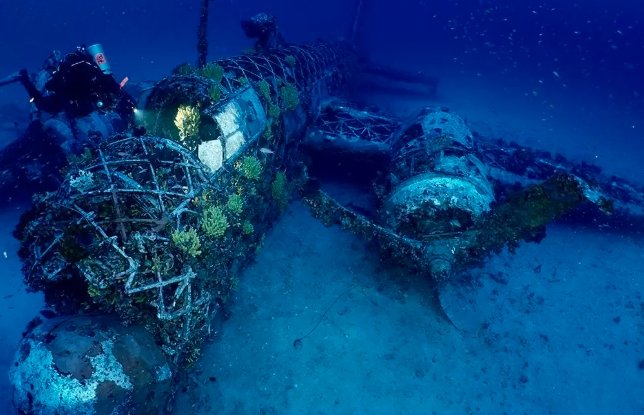Divers recover Royal Australian Air Force plane shot down by Nazis in 1943—solving a mystery that haunted three Allied families for decades.
It took more than 80 years, but the story of the Baltimore FW282 bomber finally has an ending.
The World War II-era Royal Australian Air Force (RAAF) plane was shot down by Nazi aircraft in 1943 over the Aegean Sea. Of the four-man crew, only the pilot survived. The rest—two Australians, one New Zealander—were listed as missing, believed killed.
But until now, no one knew exactly where they fell.
This week, Australian officials confirmed the discovery of the bomber’s wreckage near the Greek island of Antikythera, a find hailed as both historically significant and emotionally powerful. The families of the fallen have waited a lifetime for this moment.
A Sudden Discovery in the Depths
The plane, known as Baltimore FW282, was found by the Greek technical diving group AegeanTec during an underwater survey in 2024. Lying 200 feet beneath the surface, the wreck was astonishingly well-preserved—its airframe still recognizable despite the decades.
Once AegeanTec suspected it might be an Allied bomber, they reached out to the Australian Department of Defence. Within months, the RAAF’s History and Heritage branch confirmed what many hoped: they had found the long-lost FW282.
“It’s one of the most intact WWII aircraft discoveries we’ve seen in the region,” one official noted.

Four Men Went In—Only One Came Out
The bomber had been returning from a mission on December 3, 1943, when it was attacked by German fighters. The aircraft was struck repeatedly, catching fire as it limped across the Aegean.
Pilot William Alroy Hugh Horsley, of the RAAF, tried to keep the plane airborne. But as it lost altitude, he was knocked unconscious. When he came to, the bomber was underwater. Somehow, Horsley escaped the sinking fuselage, swam to the surface, and made it to shore—only to be captured by Nazi forces.
The other three men—Leslie Norman Row (RAF), Colin William Walker (RAAF), and John Gartside (RNZAF)—were never seen again.
Until now.
“This Aircraft Discovery Is Significant”
In a statement, Air Marshal Stephen Chappell, Chief of Air Force for the RAAF, said the discovery was more than a technical achievement—it was a human one.
“This aircraft discovery is significant,” he said. “It offers the chance to provide closure to families and honor the memory of those lost in service.”
That sentiment was echoed across the Commonwealth. New Zealand’s Air Vice-Marshal Darryn Webb said the site would be treated as a war grave, with the “respect they deserve.”
Inside the Bomber: A Timeline of Tragedy
To understand the magnitude of this discovery, it helps to know the story behind the aircraft.
| Date | Event |
|---|---|
| Dec. 3, 1943 | FW282 departs from Allied base in the eastern Mediterranean. |
| Midday | Intercepted by German fighters near the Greek coast. |
| ~12:30 PM | Shot down over the Aegean Sea. Pilot Horsley escapes; the others are presumed dead. |
| 1943–1945 | Horsley survives WWII in German captivity as a POW. |
| Post-war | The plane’s whereabouts remain unknown, and the crew is listed as MIA. |
| 2024 | AegeanTec divers locate the wreck near Antikythera. |
| April 2025 | RAAF confirms the identity of the aircraft as Baltimore FW282. |
Echoes of a Forgotten War
The find is part of a broader trend of World War II recoveries that continue to shed light on long-lost chapters of the conflict. Just last year, American researchers located two other downed planes—one off the Danish coast, the other buried deep in a French field.
But FW282 stands out for the clarity it brings.
“For decades, we knew what happened in general terms,” said a historian familiar with the case. “Now we know exactly where. That changes everything—for the families, for the record, and for our understanding of the air war over the Mediterranean.”
For the Families, Long-Awaited Closure
Perhaps no group has been more deeply moved than the relatives of the crew. For them, this wasn’t just a military footnote—it was a lifelong question that was never answered.
In statements issued by the RAAF, some surviving family members expressed gratitude and quiet relief. One described it as a “strange kind of peace.”
“These were young men in their twenties,” said a relative of Colin Walker. “They weren’t just names on a memorial. Now, at last, we know where they came to rest.”
A Legacy of Sacrifice
The bomber was part of the Martin Baltimore series, a U.S.-built aircraft used extensively by British Commonwealth forces. Though underappreciated compared to the Spitfire or Lancaster, the Baltimore played a critical role in tactical bombing operations in the Mediterranean Theater.
For the Allied airmen flying these missions, survival was never guaranteed. The skies over southern Europe were some of the most dangerous anywhere during the war.
“The generation that flew these missions understood sacrifice in a way most people today can’t,” said Air Chief Marshal Sir Richard Knighton, head of the RAF. “Their duty, their courage, still inspires us.”
The Site Will Be Protected
As word of the discovery spreads, officials have made it clear: the wreck will not be disturbed. It is a war grave, and will be treated with solemnity and respect.
Divers may revisit for monitoring or ceremonial purposes, but no artifacts will be removed.
“This isn’t a trophy,” one Australian defense spokesperson said. “It’s a final resting place.”













